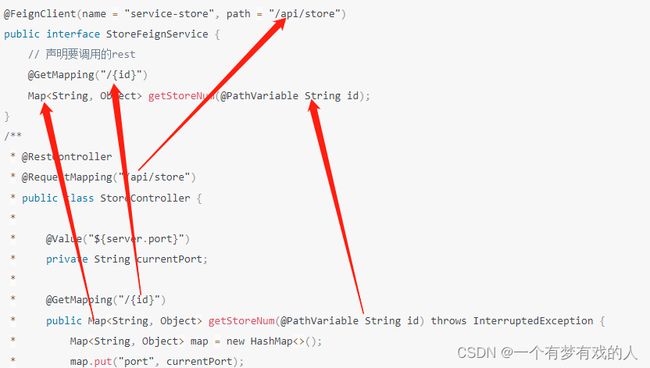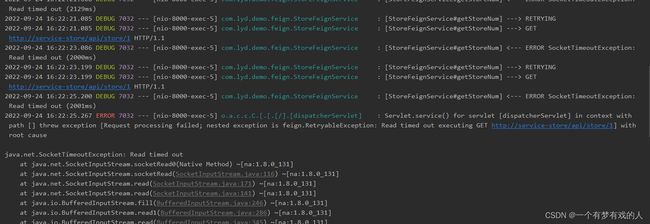【微服务】- 服务调用 - OpenFeign
服务调用 - OpenFeign
生命不息,写作不止
继续踏上学习之路,学之分享笔记
总有一天我也能像各位大佬一样
一个有梦有戏的人 @怒放吧德德
分享学习心得,欢迎指正,大家一起学习成长!
介绍
OpenFeign 全称 Spring Cloud OpenFeign,它是 Spring 官方推出的一种声明式服务调用与负载均衡组件,它的出现就是为了替代进入停更维护状态的 Feign。
Spring Cloud openfeign对Feign进行了增强,使其支持Spring MVC注解,另外还整合了
Ribbon和Nacos,从而使得Feign的使用更加方便。
Feign使用http远程调用方法就好像调用本地的方法,感觉不到是远程方法。他的使用就和直接写控制类那样,暴露接口提供调用,我们只需要编写调用接口+@FeignClient注解,在使用这个api的时候,只需要定义好方法,到时候调用这个方法就可以了。这种服务之间的调用使用起来是非常的方便,体验也比较好。
如何实现接口调用?
在平时开发的springboot项目中,像这种rest服务是如何被调用的呢?通常下是使用Httpclient、Okhttp、HttpURLConnection、RestTemplate,其中RestTemplate是最常见的。之前在 nacos配置中心 使用的是RestTemplate。
SpringCloud整合OpenFeign
就用一个例子来简单使用OpenFeign进行服务间的调用,通过实例来学习关于Feign组件的功能。
引入依赖
使用OpenFeign组件需要引入客户端依赖
<dependency>
<groupId>org.springframework.cloudgroupId>
<artifactId>spring-cloud-starter-openfeignartifactId>
dependency>
编写调用接口
通过OpenFeign远程调用服务的时候,比RestTemplate更加方便,就跟编写controller接口是差不多的。
需要写上@FeignClient注解,里面配置微服务名字和rest的@RequestMapping(“/api/store”),或者可以在声明调用pai的时候写上完整的路径。
简单的对应如下图所示

代码如下:
package com.lyd.demo.feign;
import com.lyd.demo.feign.config.FeignOkhttpConfig;
import org.springframework.cloud.openfeign.FeignClient;
import org.springframework.web.bind.annotation.GetMapping;
import org.springframework.web.bind.annotation.PathVariable;
import java.util.Map;
/**
* @author: lyd
* @description: 远程调用 service-store 服务
* @Date: 2022/9/24
* 介绍:
* name / value : 要调用的微服务名
* path:控制类上面的路径 --- @RequestMapping("/api/store")
*/
@FeignClient(name = "service-store", path = "/api/store")
public interface StoreFeignService {
// 声明要调用的rest
@GetMapping("/{id}")
Map<String, Object> getStoreNum(@PathVariable String id);
}
/**
* @RestController
* @RequestMapping("/api/store")
* public class StoreController {
* @Value("${server.port}")
* private String currentPort;
* @GetMapping("/{id}")
* public Map getStoreNum(@PathVariable String id) throws InterruptedException {
* Map map = new HashMap<>();
* map.put("port", currentPort);
* map.put("num", 10);
* return map;
* }
* }
*/
需要在启动类中写上注解 @EnableFeignClients
@Autowired
private StoreFeignService storeFeignService;
// 在业务中直接调用
storeFeignService.getStoreNum(uid);
OpenFeign自定义配置
Feign 提供了很多的扩展机制,让用户可以更加灵活的使用。
feign.Logger.Level:修改日志级别,包含四种不同的级别:NONE、BASIC、HEADERS、FULL
feign.codec.Decoder:响应结果的解析器,http远程调用的结果做解析,例如解析json字符串为java对象
feign.codec.Encoder:请求参数编码,将请求参数编码,便于通过http请求发送
feign. Contract:支持的注解格式,默认是SpringMVC的注解
feign. Retryer:失败重试机制,请求失败的重试机制,默认是没有,不过会使用Ribbon的重试
日志配置
可以通过配置Feign的日志级别来显示需要的日志。
1)、定义配置类
定义一个feign的配置文件,并交给spring管理。
feign的日志级别一开始默认是NONE,不显示任何的日志,可以通过定义一个bean,返回日志的级别
package com.lyd.demo.feign.config;
import feign.Logger;
import feign.Retryer;
import org.springframework.context.annotation.Bean;
import java.util.concurrent.TimeUnit;
/**
* @author: lyd
* @description: feign配置文件 - 日志
* @Date: 2022/9/24
*/
@Configuration
public class FeignConfig {
@Bean
public Logger.Level feignLoggerLevel() {
return Logger.Level.BASIC;
}
}
日志级别有四种:
- NONE【性能最佳,适用于生产】:不记录任何日志(默认值)。
- BASIC【适用于生产环境追踪问题】:仅记录请求方法、URL、响应状态代码以及执行时间。
- HEADERS:记录BASIC级别的基础上,记录请求和响应的header。
- FULL【比较适用于开发及测试环境定位问题】:记录请求和响应的header、body和元数据。
2)、配置文件设置级别
springboot默认的级别是info,级别比较高,需要在配置文件中配置,如果只在loggin.level下配置级别,就是全局配置,所以我们可以指定包,指定哪个包下面的日志级别。
logging:
level:
com.lyd.demo.feign: debug
3)、配置域
全局配置:
在feign配置类加上@Configuration注解,直接丢给spring来管理,达成全局配置。
局部配置:
①、局部配置可以通过在feign客户端中指定配置文件,只需要在注解后面加上指定配置类
@FeignClient(name = "service-store", path = "/api/store", configuration = FeignConfig.class)
②、局部配置还可以直接通过yml配置文件来指定。
feign:
client:
config:
service-goods: FULL # 指定哪个服务,并且赋上类型。
配置超时时间
通过yml直接配置超时时间
feign:
client:
config:
default: # 这里用default就是全局配置,如果是写服务名称,则是针对某个微服务的配置
connectTimeout: 2000
readTimeout: 2000
在store服务中加个Thread.sleep(5000),就能看到报超时异常SocketTimeoutException。

重试机制配置
通过加入bean来实现
创建重试器 (重试周期(50毫秒),最大重试周期(2000毫秒),最多尝试次数 3次 ),feign没有采用线性的重试机制而是采用的是一种指数级(乘法)的重试机制 每次重试时间 当前重试时间*= 1.5
@Bean
public Retryer retryer() {
return new Retryer.Default(50, TimeUnit.SECONDS.toMillis(2), 3);
}
在来看看default的构造器,就能更清楚参数含义。
public Default(long period, long maxPeriod, int maxAttempts) {
this.period = period;
this.maxPeriod = maxPeriod;
this.maxAttempts = maxAttempts;
this.attempt = 1;
}

如图,会进行重试,直到最后报出异常。
不仅如此,还可以配置契约设置,添加拦截器等等。。。
Feign使用优化
Feign底层发起http请求,依赖于其它的框架。其底层客户端实现包括:
- URLConnection:默认实现,不支持连接池
- Apache HttpClient :支持连接池
- OKHttp:支持连接池
这次就采用OkHttp
导入依赖
<dependency>
<groupId>io.github.openfeigngroupId>
<artifactId>feign-okhttpartifactId>
dependency>
设置配置类
package com.lyd.demo.feign.config;
import okhttp3.ConnectionPool;
import okhttp3.OkHttpClient;
import org.springframework.boot.autoconfigure.condition.ConditionalOnClass;
import org.springframework.boot.autoconfigure.condition.ConditionalOnProperty;
import org.springframework.context.annotation.Bean;
import org.springframework.context.annotation.Configuration;
import java.util.concurrent.TimeUnit;
/**
* @author: lyd
* @description: OkHttpFeign 的配置
* @Date: 2022/9/24
*/
@Configuration
@ConditionalOnClass({OkHttpClient.class})
@ConditionalOnProperty({"feign.okhttp.enabled"})
public class FeignOkhttpConfig {
@Bean
public okhttp3.OkHttpClient okHttpClient(OkhttpProperties okhttpProperties) {
return new okhttp3.OkHttpClient.Builder()
//设置连接超时
.connectTimeout(okhttpProperties.getConnectTimeout(), TimeUnit.MILLISECONDS)
//设置读超时
.readTimeout(okhttpProperties.getReadTimeout(), TimeUnit.MILLISECONDS)
//是否自动重连
.retryOnConnectionFailure(true)
.connectionPool(new ConnectionPool())
.addInterceptor(new OkHttpLogInterceptor())
//构建OkHttpClient对象
.build();
}
}
yml配置
feign:
client:
config:
default:
connectTimeout: 2000
readTimeout: 2000
httpclient:
enabled: false
okhttp:
enabled: true
connectTimeout: 4000
readTimeout: 3000
通过类获取超时时间
package com.lyd.demo.feign.config;
import lombok.Data;
import org.springframework.boot.context.properties.ConfigurationProperties;
import org.springframework.stereotype.Component;
/**
* @author: lyd
* @description: 配置参数
* @Date: 2022/9/24
*/
@Data
@Component
@ConfigurationProperties(prefix = "feign.okhttp")
public class OkhttpProperties {
private Long connectTimeout;
private Long readTimeout;
}
拦截器
可以在拦截器中配置业务需求的代码。
package com.lyd.demo.feign.config;
import lombok.extern.slf4j.Slf4j;
import okhttp3.Interceptor;
import okhttp3.Request;
import okhttp3.Response;
import okhttp3.ResponseBody;
import java.io.IOException;
/**
* @author: lyd
* @description: 拦截器
* @Date: 2022/9/24
*/
@Slf4j
public class OkHttpLogInterceptor implements Interceptor {
@Override
public Response intercept(Interceptor.Chain chain) throws IOException {
//这个chain里面包含了request和response,所以你要什么都可以从这里拿
Request request = chain.request();
long t1 = System.nanoTime();//请求发起的时间
log.info(String.format("发送请求 %s on %s%n%s",
request.url(), chain.connection(), request.headers()));
Response response = chain.proceed(request);
long t2 = System.nanoTime();//收到响应的时间
//注意这里不能直接使用response.body().string()的方式输出日志
//因为response.body().string()之后,response中的流会被关闭,程序会报错,我们需要创建出一个新的response给应用层处理
ResponseBody responseBody = response.peekBody(1024 * 1024);
log.info(String.format("接收响应: [%s] %n返回json:【%s】 %.1fms%n%s",
response.request().url(),
responseBody.string(),
(t2 - t1) / 1e6d,
response.headers()));
return response;
}
}
引入配置
@FeignClient(name = "service-store", path = "/api/store", configuration = FeignOkhttpConfig.class)
创作不易,可能有些语言不是很通畅,如有错误请指正,感谢观看!记得点赞哦!

